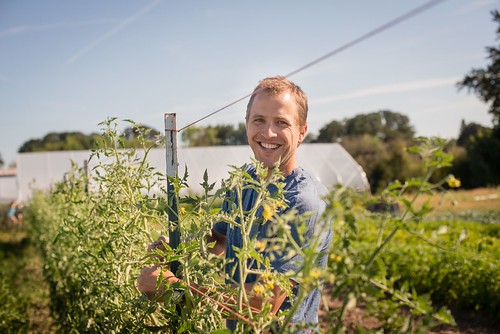
More and more farmers are entering the organic market. Just last year, the number of certified operations in the U.S. grew by almost 12 percent - more than double the growth rate of 2014. So how do farmers, ranchers, and food processors make the transition to organic? We talked to one farming family about their experience, learning how they used USDA programs to help with the transition process.
Conner Voss got his family farm certified organic in 2015. Diggin’ Roots Farm is a diversified fruit, vegetable, and livestock operation in Molalla, Oregon, midway between Portland and Salem. “We sell our product direct – through a CSA, at a local farmers market, and direct to restaurants – and our customers kept asking about our growing practices,” said Conner. “We wholeheartedly believe in the practices and philosophy of organic production, and certification offers a quick and easy starting place for our conversations with our community. Beyond that, being certified is a way for our small farm to actively engage in the larger organic movement by helping define and shape what organic is.”
USDA’s Natural Resources Conservation Service (NRCS) programs provided Diggin’ Roots with financial assistance for conservation practices during the transition to organic. “Through NRCS’ Environmental Quality Incentives Program’s Organic Initiative, we established nitrogen-fixing cover crop mixes, developed a nutrient budget for using organic fertilizers, and built a high tunnel. Our current contract includes extensive perennial plantings for buffers and beneficial insects. NRCS has really helped us fine tune our fertility and address a broad range of conservation concerns on our farm,” said Conner. “In addition, we use the Agricultural Marketing Service’s (AMS) Organic Certification Cost Share program to defray the cost of organic certification. It can cover up to 75 percent of our certification fees each year. Our first year of certification cost us about $300, which ended up being less than .5 percent of our gross sales- well worth it for the time it saved us in communicating our growing practices.”
USDA’s strategic plan set out a goal of helping farms like Diggin’ Roots obtain organic certification, and Secretary Vilsack issued guidance (PDF, 95.6 KB) to all USDA agencies affirming the department-wide commitment to the organic sector. AMS and NRCS have taken the lead on creating new education and outreach tools aimed at making certification more accessible, attainable, and affordable for small and beginning farmers. Recently, AMS developed a number of tools to help producers understand how to make the transition to organic certification. The Sound & Sensible Certification tools provide videos, fact sheets, and training curricula on organic agriculture, and the Organic Educational Toolkit provides webinars, posters, brochures, and in-depth guides to USDA programs for organic farmers, ranchers, and food processors. NRCS also developed a number of conservation tools, publishing an Organic Farming Handbook and hosting over 30 webinars on organic agriculture.
USDA’s National Institute of Food & Agriculture, USDA’s Risk Management Agency, and the Sustainable Agriculture Research and Education Program have also funded numerous tools to help producers understand how to transition from conventional to organic production. Below are a few highlights.
- Organic Transition: A Business Planner for Farmers, Ranchers, and Food Entrepreneurs (University of Minnesota)
- Making the Transition to Organic: Ten Farm Profiles (University of Minnesota)
- Organic Transition Course – 15-hour online course from the Rodale Institute
- Farm Transitions: Valuing Sustainable Practices—Organic Certification (Land Stewardship Project)
Conner sums it up like this: “Farming is my intersection between purpose, family, and place. Growing food that makes people smile is my privilege. It is incredibly encouraging that the USDA is recognizing the value of our nation’s organic farms. We feel fortunate to have been provided this assistance and actively promote these programs to our peers.”


